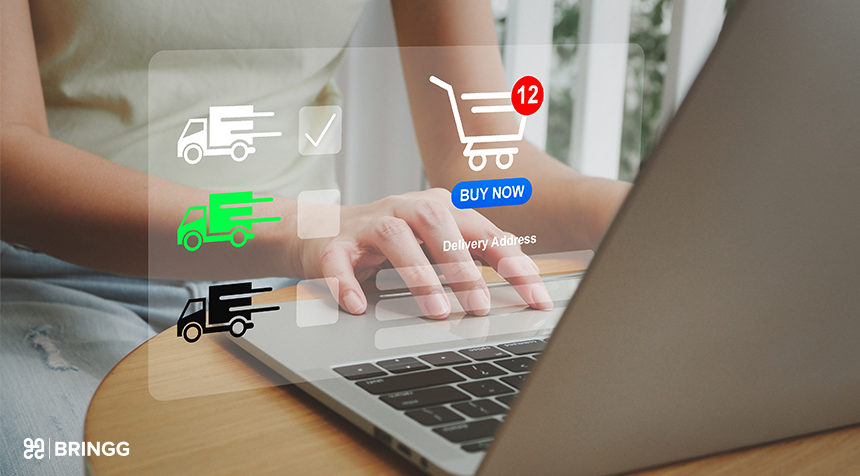In today’s rapidly evolving retail landscape, last mile delivery has become a critical battleground for businesses looking to balance costs against economic uncertainty while striving to meet rising consumer demand. According to a 2022 report from Salesforce, 88% of consumers agree that the experience a company provides is as important as its products or services, so delivering on the promise of a seamless customer experience, from checkout through delivery, has quickly gone from being as ‘nice to have’ to paramount. When you layer on the fact that 49% of retailers lack the flexibility needed to scale their fleet up and down during peak season, the urgency becomes even more apparent.
With competition high, relying on a limited number of carriers can leave your business not only incapable of keeping up with consumers who crave flexible shipping and fulfillment options, but also vulnerable to last mile disruptions. In this blog post, we will explore the risks of relying on a limited number of carriers and shed light on the need for, and benefits of, regional carrier diversification to insulate against ‘what ifs’ and optimize last mile delivery operations.
What is carrier diversification?
So what is carrier diversification and why should it be top-of-mind for retailers, especially as we head into peak season? Simply put, carrier diversification is leveraging a connected ecosystem of integrated carriers to manage pickups and dropoffs (the 1st mile), over the road transit and drop off (the last mile). But the true strength of diversification exists not just in having options for all 3 use cases, but being able to optimize on the fly depending on your location as the shipper, the recipient’s location, and the various factors in between.
The Risks of Relying on a Single Carrier
When a retailer places all shipping hopes in one basket, it becomes vulnerable to the ‘what if’ scenarios that can disrupt the entire supply chain. Here are some of the major risks associated with relying on a single or very few carriers:
1. Driver Capacity Constraints: What if there aren’t enough drivers available just when you need them the most? Insufficient driver capacity (which can happen for many reasons, often beyond a company’s control) can quickly lead to delays and missed delivery windows, negatively impacting customer satisfaction.
2. Variation in Service Levels: Carriers each have different service levels, with varying strengths – and weaknesses that may impact specific shipment types. By diversifying, you can adjust offerings to match customer needs based on a multitude of factors.
3. Use Case Limitations: What if a particular town or region is not served by your carrier? Limited geographical coverage could alienate potential customers and hinder expansion into new markets. Regional diversification is also key to strengthen local markets that could rely on gig economy and/ or preferred sustainable deliveries.
4. Technical and Local Dependencies: What if your carrier’s system goes offline for a significant period of time? What if local or company wide strikes are on the immediate horizon? These kinds of outages can disrupt order processing, and potentially leave you scrambling to find alternative solutions.
The Benefits of Carrier Diversification
The adoption of a carrier diversification strategy offers several advantages that can enhance the efficiency and reliability of last mile delivery operations.
1. Granular Coverage with Local Specialization: Regional carriers can provide extensive coverage within specific geographic areas, allowing them to cover shorter distances in less time. The increased proximity to customers enables faster deliveries and the ability to offer competitive shipping rates.
2. Mitigating Delivery Impacts: When unified in a single technology platform, various carriers can be easily managed. Mitigating redundancies within the network can reduce risks, and help you keep shipping guarantees intact. If one carrier is unable to fulfill a delivery, another can seamlessly take over, ensuring the customer receives their order as expected.
3. Pre-Integrated Carriers: A global network of pre-integrated carriers, like Bringg’s Delivery Hub, holds the power to offer retailers access to a wide range of carriers – from parcel, to same day and LTL – simplifying the onboarding process and reducing the time and cost associated with integrating new carriers.
4. Unified Consumer Experience: A delivery network that is unified by a single technology can maintain a consistent and branded customer experience from checkout to delivery and returns, regardless of which carrier is handling the shipment.
5. Unified Technology Stack
Effective last mile delivery doesn’t exist in isolation; it requires seamless integration with the rest of your tech stack, including your ecommerce, order management system (OMS), and warehouse management systems (WMS). Partnering with a vendor that works proactively with your tech stack will reduce the risk of project failures. This partnership also opens the door to enhanced business solutions by embracing co-innovation opportunities together with your vendors.
Conclusion
In Conclusion: Embrace Technology to Diversify Operations
In the fast-paced world of retail, last mile delivery plays a pivotal role in shaping the customer experience. Recognizing the risks of relying on a single carrier, and embracing the opportunities that come with regional carrier diversification is essential for achieving reliable, efficient, and customer-centric shipping operations.
By integrating your carrier network into a unified technology platform, you can mitigate delivery impacts, reduce risks, and foster brand loyalty. Moreover, seamless integration with your tech stack opens the door to co-innovation and improved operational performance, ensuring your business stays ahead of the competition. If you haven’t already, it’s time to embrace the power of regional carrier diversification to secure your place at the forefront of modern last mile delivery excellence.
Learn more about Bringg’s Delivery Management app on Salesforce



